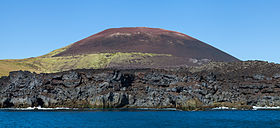Eldfell and the 1973 Eruption on Heimaey Island
Eldfell and the 1973 Eruption on Heimaey Island
Eldfell (Fire Mountain) is a 200m high crater overlooking the town on Heimaey, the only inhabited island of the Vestmannaeyjar (Westman Islands) archipelago.
Following a series of earthquakes in the preceding days, the island's residents were awoken by fire engine sirens early on 23rd January 1973. A 200m long fissure was erupting a kilometre barely from the town. Soon the fissure spanned the island, erupting 150m high lava fountains, which formed a lava flow fast approaching the town.
As storms in the preceding days had brought the entire fishing fleet back to harbour, the town's 5,300 inhabitants were swiftly evacuated once the seriousness of the eruption became apparent. They abandoned their homes and fled, unsure of when or if they would return nor whether their houses will still be there.
As the eruption progressed, the activity concentrated around one vent, building up a huge crater, which was named Eldfell. The lava continued to advance and threatened to close the entrance to the harbour. This would have ruined the fishing industry and destroyed the main livelihood of the inhabitants. A plan was devised to pump seawater to cool the advancing lava, and this proved to be surprisingly successful. Initially, the pumps capacity was limited to about 400 litres per second, but this was greatly increased with the arrival of 32 pumps from the USA, each with a capacity of 1000 litres per second.
The eruption lasted until early July, causing extensive damage to the town. One-third of the houses went under lava, caught fire or were destroyed by ash falls. By the end of the eruption, the island's surface area had increased by 2.5 square kilometres.
You can walk to the top of Eldfell for great views over the town, the islands and across to the mainland, where another volcano, snow-capped Eyjafjallajökull, dominates the horizon. Steam still rises from Eldfell’s summit where you can feel the heat through the rocks. It is not advisable to climb the crater in high winds.


